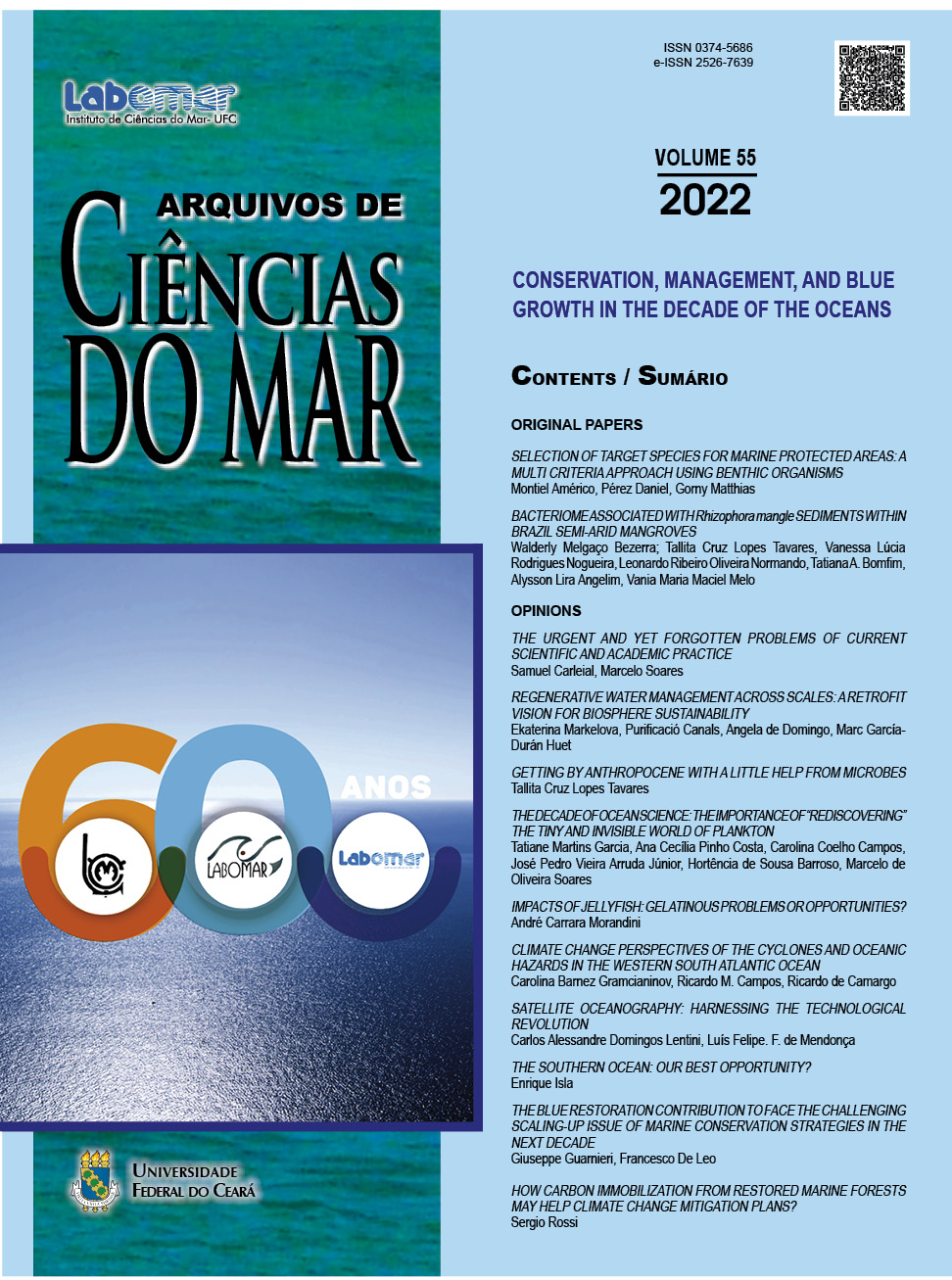COASTAL OCEAN ACIDIFICATION IN BRAZIL: A BRIEF OVERVIEW AND PERSPECTIVES
Acidificação do oceano costeiro no Brasil: uma breve avaliação e perspectivas
DOI:
https://doi.org/10.32360/acmar.v55iEspecial.78514Abstract
This perspective paper aims at presenting the current knowledge on the processes of ocean acidification (OA) and coastal acidification (CA) in the Brazilian coastal ocean. We define and differentiate the processes of OA and CA: the first driven by the actual global increase of atmospheric carbon dioxide (CO2); the second driven by a combination of ocean uptake of atmospheric CO2 and other local/regional chemical additions or subtractions in aquatic ecosystems at the land-ocean interface. Regarding OA, we have centered our analysis on the data available for the main water masses along the Brazilian coast: South Atlantic Central Water (SACW), Tropical Water (TW), and Coastal Water (CW). The few data available for the shallow coastal waters (< 200 m depth) of the continental shelf reveal an increase in the anthropogenic component of the total dissolved inorganic carbon (DIC) pool in the SACW, with a decline in the ocean pH (over two decades; 1993-2013), and in the saturation state of calcium carbonate (CaCO3) minerals. We could not find OA trends for TW and CW because no data was available. Overall, the colder water masses (SACW, Plata Plume) have lower buffering capacity and simulations show that will potentially experience earlier negative OA impacts than the warmer waters masses (TW, Amazon Plume). Regarding CA, we have identified some local/regional studies investigating the carbonate chemistry in nearshore/estuarine ecosystems, particularly on the quantification of sources and sinks of CO2 , and determining short-term variabilities. Apparently, spreading coastal eutrophication in Brazil can enhances or reduces the process of OA, depending on the net ecosystem metabolism in combination with other chemical alterations. However, we could not find medium-long term acidification trends due to the limited data. There is a limited
capacity to produce long time-series of carbonate chemistry parameters in key ecosystems and regions along the Brazilian coast. This lack of past information hinders and impairs the scientific community for identifying potential patterns of acidification along the Brazilian coast. We call for an urgent action in Brazil, with emphasis on the establishment of moored buoys/stations and/or scientific programs in the long term with continuous, real-time measurements of the main carbonate chemistry parameters.
Keywords: ocean acidification, coastal acidification, coastal eutrophication, continental shelf, Southwestern Atlantic Ocean
Downloads
Published
Issue
Section
License
1. Proposta de Política para Periódicos de Acesso Livre
Autores que publicam nesta revista concordam com os seguintes termos:
- Autores mantém os direitos autorais e concedem à revista o direito de primeira publicação, com o trabalho simultaneamente licenciado sob a Licença Creative Commons Attribution que permite o compartilhamento do trabalho com reconhecimento da autoria e publicação inicial nesta revista.
- Autores têm autorização para assumir contratos adicionais separadamente, para distribuição não-exclusiva da versão do trabalho publicada nesta revista (ex.: publicar em repositório institucional ou como capítulo de livro), com reconhecimento de autoria e publicação inicial nesta revista.
- Autores têm permissão e são estimulados a publicar e distribuir seu trabalho online (ex.: em repositórios institucionais ou na sua página pessoal) a qualquer ponto antes ou durante o processo editorial, já que isso pode gerar alterações produtivas, bem como aumentar o impacto e a citação do trabalho publicado (Veja O Efeito do Acesso Livre).

